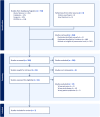Tranexamic Acid in Patients Undergoing Liver Resection: An Updated Systematic Review and Meta-Analysis of Randomized Controlled Trials
- PMID: 40388700
- PMCID: PMC12089727
- DOI: 10.1177/10760296251342467
Tranexamic Acid in Patients Undergoing Liver Resection: An Updated Systematic Review and Meta-Analysis of Randomized Controlled Trials
Abstract
BackgroundTranexamic acid (TA), a synthetic lysine derivative, is known for its antifibrinolytic effect and potential to reduce bleeding in surgeries like arthroplasty, cardio-aortic procedures, and liver transplantation. This meta-analysis seeks to provide robust clinical evidence on TA's effectiveness in reducing blood loss and transfusion needs during orthotopic liver transplantation.MethodsThe systematic review and meta-analysis included the relevant randomized controlled trials (RCTs) retrieved from PubMed, EMBASE, Web of Science, Cochrane, and SCOPUS databases until August 2024. The meta-analysis was done using (RevMan 5.4.1). PROSPERO ID: CRD42024589151.ResultsOur meta-analysis of seven RCTs with 1875 patients found no significant differences between TA and control groups in total red blood cell units transfused (MD: -3.74 units; 95% CI [-8.49, 1.01]; P = .12), perioperative transfusions (MD: -0.42 units; 95% CI [-3.17, 2.32]; P = .76), or overall blood loss (MD: -167.81 mL; 95% CI [-415.29, 79.67]; P = .18).For safety outcomes, TA was associated with a higher rate of venous thromboembolism events (RR: 1.71; 95% CI [1.01, 2.87]; P = .05; event rate: 4.89% vs 2.91%), while no significant differences were found in other surgical complications (RR: 1.12; 95% CI [0.92, 1.37]; P = .26).ConclusionTA does not reduce blood loss or the need for postoperative transfusions in orthotopic liver transplantation and may raise thrombotic risk. Caution is required to interpret these results due to variations in the study/hospital-specific transfusion protocol details. Larger studies are needed to confirm these findings, and future research should explore the effects of multiple dosing regimens on blood loss and transfusion requirements.
Keywords: liver resection; meta-analysis; tranexamic acid.
Conflict of interest statement
Declaration of Conflicting InterestsThe authors declared no potential conflicts of interest with respect to the research, authorship, and/or publication of this article.
Figures





Similar articles
-
Desmopressin use for minimising perioperative blood transfusion.Cochrane Database Syst Rev. 2017 Jul 10;7(7):CD001884. doi: 10.1002/14651858.CD001884.pub3. Cochrane Database Syst Rev. 2017. PMID: 28691229 Free PMC article.
-
Drugs to reduce bleeding and transfusion in major open vascular or endovascular surgery: a systematic review and network meta-analysis.Cochrane Database Syst Rev. 2023 Feb 17;2(2):CD013649. doi: 10.1002/14651858.CD013649.pub2. Cochrane Database Syst Rev. 2023. PMID: 36800489 Free PMC article.
-
Effectiveness of tranexamic acid in reducing blood loss during cytoreductive surgery for advanced ovarian cancer.Cochrane Database Syst Rev. 2016 Jan 23;2016(1):CD011732. doi: 10.1002/14651858.CD011732.pub2. Cochrane Database Syst Rev. 2016. PMID: 26801659 Free PMC article.
-
Tranexamic acid for preventing postpartum haemorrhage after caesarean section.Cochrane Database Syst Rev. 2024 Nov 13;11(11):CD016278. doi: 10.1002/14651858.CD016278. Cochrane Database Syst Rev. 2024. PMID: 39535297 Free PMC article.
-
Anti-fibrinolytic use for minimising perioperative allogeneic blood transfusion.Cochrane Database Syst Rev. 2011 Mar 16;2011(3):CD001886. doi: 10.1002/14651858.CD001886.pub4. Cochrane Database Syst Rev. 2011. PMID: 21412876 Free PMC article.
References
-
- Dhar VK, Wima K, Lee TC, et al. Perioperative blood transfusions following hepatic lobectomy: A national analysis of academic medical centers in the modern era. HPB (Oxford). 2019;21(6):748‐756. - PubMed
-
- Kusano T, Sasaki A, Kai S, et al. Predictors and prognostic significance of operative complications in patients with hepatocellular carcinoma who underwent hepatic resection. Eur J Surg Oncol J Eur Soc Surg Oncol Br Assoc Surg Oncol. 2009;35(11):1179‐1185. - PubMed
-
- Katz SC, Shia J, Liau KH, et al. Operative blood loss independently predicts recurrence and survival after resection of hepatocellular carcinoma. Ann Surg. 2009;249(4):617‐623. - PubMed
Publication types
MeSH terms
Substances
LinkOut - more resources
Full Text Sources

